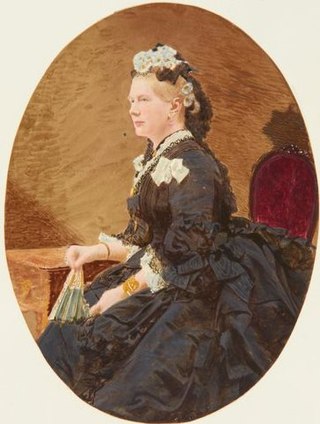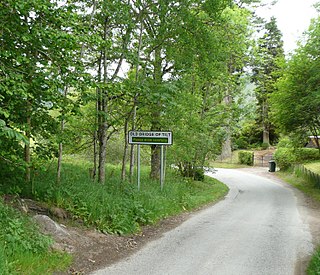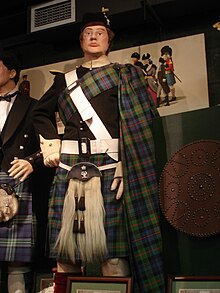
Duke of Atholl, named for Atholl in Scotland, is a title in the Peerage of Scotland held by the head of Clan Murray. It was created by Queen Anne in 1703 for John Murray, 2nd Marquess of Atholl, with a special remainder to the heir male of his father, the 1st Marquess.

Pitlochry is a town in the Perth and Kinross council area of Scotland, lying on the River Tummel. It is historically in the county of Perthshire, and has a population of 2,776, according to the 2011 census.

Blair Atholl is a village in Perthshire, Scotland, built about the confluence of the Rivers Tilt and Garry in one of the few areas of flat land in the midst of the Grampian Mountains. The Gaelic place-name Blair, from blàr, 'field, plain', refers to this location. Atholl, which means 'new Ireland', from the archaic Ath Fhodla is the name of the surrounding district.

John Murray, 11th Duke of Atholl, was a South African-born hereditary peer of the Peerage of Scotland, hereditary Clan Chief of Clan Murray, and Colonel-in-Chief of the Atholl Highlanders. As Duke of Atholl, he commanded the only legal private army in Europe. He acceded as the 11th duke on 27 February 1996, succeeding his second cousin, once removed, The 10th Duke of Atholl.

Blair Castle stands in its grounds near the village of Blair Atholl in Perthshire in Scotland. It is the ancestral home of the Clan Murray, and was historically the seat of their chief, the Duke of Atholl, though the current (12th) Duke, Bruce Murray, lives in South Africa. The castle stands in Glen Garry, and commands a strategic position on the main route through the central Scottish Highlands.

Anne Murray, Duchess of Atholl VA, born Anne Home-Drummond and known as The Lady Glenlyon between 1839 and 1846, as The Duchess of Atholl between 1846 and 1864 and as The Dowager Duchess of Atholl between 1864 and 1897, was a Scottish courtier and close friend of Queen Victoria.

The Lonach Highlanders are members of the Lonach Highland and Friendly Society, made up of men from the Strathdon area of Aberdeenshire in Scotland. The society was formed in 1823. The principal aims of the Society are the preservation of Highland dress and the Gaelic language; to support loyal, peaceable manly conduct and the promotion of social and benevolent feelings among the inhabitants of this district. However, the Strathdon dialect of Gaelic has become extinct since their formation so it is arguable how successful they have been in that aim.

The Solomon Mahlangu Regiment is a reserve infantry regiment of the South African Army.

George Iain Murray, 10th Duke of Atholl, DL, known as Wee Iain, was a Scottish peer and landowner.

The Cape Town Highlanders is a reserve mechanised infantry regiment of the South African Army.

John Murray, 4th Duke of Atholl, KT, PC, FRS, styled Marquess of Tullibardine from 1764 to 1774, was a Scottish peer.

George Augustus Frederick John Murray, 6th Duke of Atholl, was a Scottish peer, important landowner, and freemason.

Clan Murray is a Highland Scottish clan. The chief of the Clan Murray holds the title of Duke of Atholl. Their ancestors were the Morays of Bothwell who established the family in Scotland in the 12th century. In the 16th century, descendants of the Morays of Bothwell, the Murrays of Tullibardine, secured the chiefship of the clan and were created Earls of Tullibardine in 1606. The first Earl of Tullibardine married the heiress to the Stewart earldom of Atholl and Atholl therefore became a Murray earldom in 1626. The Murray Earl of Atholl was created Marquess of Atholl in 1676 and in 1703 it became a dukedom. The marquess of Tullibardine title has continued as a subsidiary title, being bestowed on elder sons of the chief until they succeed him as Duke of Atholl.

John Murray, 5th Duke of Atholl was a duke in the Peerage of Scotland, a British Army officer and a major landowner in Scotland. Declared insane at the age of twenty, he never sat in the House of Lords.

A Scottish regiment is any regiment that at some time in its history has or had a name that referred to Scotland or some part thereof, and adopted items of Scottish dress. These regiments were created after the Acts of Union in 1707 between England and Scotland, either directly serving Britain during its various wars, or as part of the military establishments of Commonwealth countries. Their "Scottishness" is no longer necessarily due to recruitment in Scotland nor any proportion of members of Scottish ancestry.

The Scottish Horse was a Yeomanry regiment of the British Army's Territorial Army raised in 1900 for service in the Second Boer War. It saw heavy fighting in both the First World War, as the 13th Battalion, Black Watch, and in the Second World War, as part of the Royal Artillery. It amalgamated with the Fife and Forfar Yeomanry to form the Fife and Forfar Yeomanry/Scottish Horse in 1956. The lineage is maintained by "C" Fife and Forfar Yeomanry/Scottish Horse Squadron of The Scottish and North Irish Yeomanry based in Cupar in Fife.
Lieutenant-General James Murray, was a Scottish soldier and politician who sat in the House of Commons from 1773 to 1794.

Bridge of Tilt is a village in Perthshire, Scotland, built around the River Tilt, near its confluence with the River Garry. It is 5+3⁄4 miles northwest of Pitlochry. The newer part of the village is continuous with Blair Atholl, only separated by the River Tilt. The village is located primarily on the B8079 between Pitlochry and Dunalastair Water, but the older part of the village is located further up the River Tilt. The A9 runs past the River Garry to the south of Bridge of Tilt, and connects the village with Newtonmore and Inverness in the north and Pitlochry, Perth and Stirling in the south.

The siege of Blair Castle was a conflict that took place in Scotland in March 1746 and was part of the Jacobite rising of 1745. It was fought between Scottish forces loyal to the British-Hanoverian government of George II of Great Britain, which defended Blair Castle near the village of Blair Atholl in Perthshire, and Scottish Jacobite forces loyal to the House of Stuart.

Bruce George Ronald Murray, 12th Duke of Atholl, is a South African-born hereditary peer in the Peerage of Scotland and Chief of Clan Murray. As Duke of Atholl, he has the right to raise Europe's only legal private army, the Atholl Highlanders, a unique privilege granted to his family by Queen Victoria after visiting Blair Atholl in 1844.



















